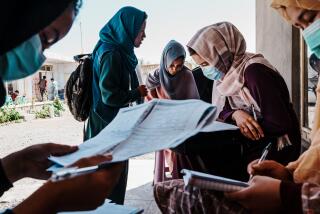Help Poor Women to Help Themselves
In these times of uncertainty, poor women could very well be our greatest allies in efforts to create stability and progress in war-torn regions.
In Afghanistan, for instance, women may be able to help lift their families out of the grinding poverty that breeds fanaticism. With the assistance of microcredit programs, women can create business opportunities for themselves and rebuild social networks that serve Afghan society.
Most poor women in Afghanistan already have the skills necessary to contribute to their households’ earnings, but they lack the capital to make these skills profitable.
When economic aid is directed to women, earnings from their informal businesses--such as dressmaking and carpet-weaving--increase and are more likely than their husbands’ earnings to go toward improving the nutrition, housing and education of their children.
This type of bottom-up approach is essential for meeting the immediate needs of families whose lives are devastated by poverty.
Take Khursheed Baji, a widow living in a poor area of Pakistan. Three years ago her husband died, and her eight-member family could barely meet its daily needs through her sons’ meager income from factory labor. With a loan of about $70 from Kashf Foundation, a nonprofit organization providing microcredit services in Lahore, Baji was able to open a tiny, home-based business selling sweets and other small items to children in her community.
With the remainder of her loan, she purchased a sewing machine for making doll clothes and stitching embroidery.
She earns a 30% profit from her sweets shop, and orders continue to flow in for her sewing business. Now, even when times are tough, she says, there is never the worry of going hungry.
Microcredit programs often provide a variety of nonfinancial services as well, such as basic business training and the opportunity for women to gather together for mutual support.
The simple act of meeting with other women once a week for loan repayment and sharing of experiences begins the process of developing confidence and skills to move out of the trap of poverty.
In Afghanistan, where women have been all but shut out of the public arena, the need to include women in development, particularly the very poorest women, should be obvious.
What may not be as obvious is the impact that the empowerment of women can have on entire societies.
Empowered women are more likely to seek medical attention for their ill children, to participate in local government and to send their daughters to school.
In 1998, a World Bank study on the Grameen Bank, which has been providing microcredit services in Bangladesh since the 1970s, found that in a typical year 5% of their borrowers (or 125,000 families) rise above the poverty line.
Another important finding of the study shows that for every 1% increase in borrowing by a female Grameen member, the probability of her daughter enrolling in school was increased by 1.9%. An increase in borrowing by male members had no significant impact on their daughters’ schooling.
From 1997 to 2000, the number of very poor microcredit clients worldwide has grown from 7.6 million to 19.3 million.
Women microcredit clients report feeling more prosperous and more hopeful about their lives and the lives of their children and better able to deal with crises that may arise.
This is the sort of hope and steady progress toward a better future that fosters peace, freedom and stability.
More to Read
Sign up for Essential California
The most important California stories and recommendations in your inbox every morning.
You may occasionally receive promotional content from the Los Angeles Times.










